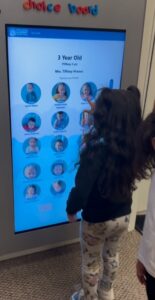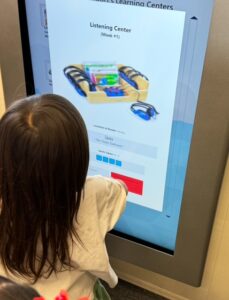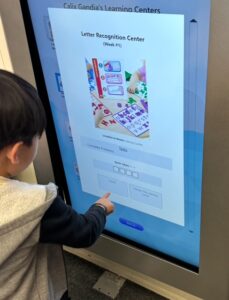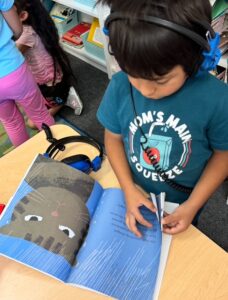Academics
The SNACS Model: Making Learning Meaningful & Fun through Innovative Technology
At SNACS students begin a journey of discovery. At the heart of every personalized project is an academic challenge that will spark innovation and develop critical skills. Our students thrive on these hands-on, self-directed learning opportunities because they are always surrounded by a supportive, caring community. Through the SNACS PLAY® Model, we strive for an innovative education providing personalized learning through choice, play, and exploration. SNACS is the first school to implement the PLAY Interactive Choice Board, a learning management system designed by Dr. Regan, to support teacher efficiency, efficacy, student engagement, and achievement. SNACS was recently featured in an All Access Public Television Docuseries on Changing Education through Innovation. Click the link to view the video.
https://www.allaccessptv.com/features-id1124005342/
Learn more about the PLAY® Model and PLAY® Interactive Choice Board below.
The SNACS PLAY® Model:
- Utilizes the first-ever PLAY® Interactive Choice Board
- Design classrooms like a discovery museum
- Provides standards-based learning centers
- Provides learning through play and exploration
- Personalizes learning
- Provides choice
- Supports academic achievement and growth
- Instills student responsibility and accountability
- Provides a progressive curriculum
- Provides small group instruction
- Assesses students supportively and thoroughly
- Uses data to drive instruction
Watch the SNACS documentary video to learn more about the PLAY® Model.
The PLAY® Model

In a more traditional education model, we often see large blocks of time spent on whole-group instruction. Consider a typical third-grade classroom, where the teacher provides direct instruction in the front of the classroom. The students may range in ability from first to fifth grade, and the teacher teaches to the majority of ability. The students with lower abilities don’t understand the instructions, and students with higher abilities are bored.
The PLAY® Model at SNACS has a different approach to instruction to maximize teacher instruction, student engagement, and achievement. All students have Personalized Learning Plans detailing their ability level across subjects with goals by quarter/trimester. Every classroom is designed like a discover museum with multiple standards-based learning center experiences for students to learn in. Learning centers have specific activities or projects that are personalized (individualized and differentiated) based on standards, modalities, multiple intelligences, depth of knowledge, and interests.

Teachers utilize the PLAY® Interactive Choice Board to display available centers students can work in. Teachers teach center and ICB procedures and establish rules to require certain core centers (must-do’s) each week. Teachers custom design and control display and capability features through the web portal.
Once students learn the procedures using PLAY® Interactive Choice Board and learning centers, students engage inlearning with minimal teacher direction. They learn to self-regulate their time and make choices to meet requirements of completing must-do’s within an established time. When students make choices to engage in learning centers, it promotes agency, self-regulation, metacognition, executive functioning, brain development and neuroplasty, 21st century use of technology, and increased engagement and achievement. Students learn to apply these skills when makingdecisions across school experiences and in life.
 Teachers have time to: pull small instruction and intervention groups, work with individual students, facilitate inquiry-based learning, conduct authentic observations, and attend to non-instruction interruptions without interrupting student learning. As a result of implementing the model with fidelity using the PLAY® Interactive Choice Board, teachers are more effective with their use of time, classroom and small group instruction and intervention management and providing for varied instructional strategies. It builds teacher efficacy in their ability to perform effectively to meet the needs of students.
Teachers have time to: pull small instruction and intervention groups, work with individual students, facilitate inquiry-based learning, conduct authentic observations, and attend to non-instruction interruptions without interrupting student learning. As a result of implementing the model with fidelity using the PLAY® Interactive Choice Board, teachers are more effective with their use of time, classroom and small group instruction and intervention management and providing for varied instructional strategies. It builds teacher efficacy in their ability to perform effectively to meet the needs of students.
PLAY® Interactive Choice Boards
SNACS implemented the first-ever PLAY® Interactive Choice Board Learning Management System (LMS) during the 2024-25 school year, which supports a standards-driven center-based learning educational climate where accountability is embedded within the daily life of the classroom. Successful development and implementation of the instructional model and associated technology serves as a catalyst to change the current approaches in education.
2024-25 school year, which supports a standards-driven center-based learning educational climate where accountability is embedded within the daily life of the classroom. Successful development and implementation of the instructional model and associated technology serves as a catalyst to change the current approaches in education.
Teachers design the PLAY® Interactive Choice Board to display all available centers for students to work in. Teachers can design more than one Choice Board display screen if they want to separate content areas, like literacy and math, to implement at different times of the day. So, for example, a teacher may design and implement a literacy-focused choice board with literacy specific standards-based learning centers to implement during their language arts time block. During this time, they will pull small ability-based groups to provide instruction and intervention while all other students are working in learning centers. Teachers may design and implement a math-focused choice board with math specific standards-based learning centers to implement during their math clock. Or teachers may integrate multiple subjects into one board.
 On the back end, teachers determine how many students can work within each learning center. Limiting the number of students in each learning center ensures students work in small groups or as individuals throughout the classroom. Space is organized and students are focused.
On the back end, teachers determine how many students can work within each learning center. Limiting the number of students in each learning center ensures students work in small groups or as individuals throughout the classroom. Space is organized and students are focused.
All learning centers are differentiated and individualized for learning. Students use the PLAY® Interactive Choice Board to select which learning center they want to work in. Students work in learning centers on specific activities, projects, and assignments as assigned by the teacher. Students may choose to switch learning centers by returning to the Choice Board.
Once students learn the procedures using PLAY® Interactive Choice Board and learning centers, students engage in learning with minimal teacher direction. They learn to manage their time and make choices to meet requirements of completing must-do’s within an established time. When students make choices to engage in learning centers, it promotes agency, self-regulation, metacognition, executive functioning, brain development and neuroplasty, 21st century use of technology, and increased engagement and achievement. Students learn to apply these skills when making decisions across school experiences and in life.
Teachers/leaders generate reports by student/center to make instructional decisions and to share with families. Students, teachers, families, and leaders can see student choices in real time or with historical reports.
The PLAY® Model and implementation of the PLAY® Interactive Choice Board supports brain development and neuroplasty, executive functioning, metacognition, agency, self-regulation, and other areas. To learn more about the PLAY® Interactive Choice Board, click the links below.
- Visit the SNACS blog – https://www.snacs.org/dr-kimberly-regan-shaping-the-education-world/
- Visit This is Reno featured article: https://thisisreno.com/2024/08/sierra-nevada-academy-charter-school-marks-its-25th-year-innovative-initiative-sponsored
Testimonials
One study revealed 76% of kindergarten students were able to complete required five “must-do” centers within a week without teacher intervention, which allowed the teacher to support 24% toward agency and self-regulation in making choices.
As adults we get to make choices all the time. Kids usually don’t get to do that, so for them to make choices all the time is really cool. – First Grade Teacher
Students have their day planned out and know what’s expected of them. So centers keep them focused on learning in a focused way. – Second Grade Teacher
Students are so engaged during choice time that they want to keep working in centers instead of going out to recess. I have to urge them to go to recess. – Third Grade Teacher
I’ve seen a lot of accountability with my choice centers. Having student must dos and can dos, students understand what they need to complete. They often complete their must dos before their can dos. It creates responsibility and allows me to meet their needs with more individualized instruction during center time. – Fifth Grade Teacher
They can work at their own pace with a small group of students. They are more likely to dig in and learn more than in a large group setting. – Special Education Teacher
Digging Deeper: The PLAY® Model and Key Components
PLAY®
PLAY® is an acronym for Promoting Learning and Accountability with Young children / Youth (depending on age). PLAY® is at the core allowing for students to learn through play and exploration while being accountable to engagement and achievement.
Play Theory
Play theory is central to the instructional model. Play theory evolved from the work of Jean Piaget, Lev Vygotsky, Margaret Mead, and Erik Erikson. Play involves multidimensional qualities supporting social emotional, cognitive, and physical learning through playing and exploration. Play can be spontaneous, guided and directed. Play, at the center of the curriculum, is based on Developmentally Appropriate Practice. Typically, play is associated with early childhood classrooms. This model calls for play-based learning across all grade levels and subject matter as a central force in student engagement, achievement, and building global citizenship. Play is a valuable force in overcoming barriers including cultural, ethnic, socio-economic, and gender stereotypes.
Play is viewed as a necessity, not a laizze-faire commodity in the learning environment. Intentionality is key to a carefully orchestrated environment that fosters specific objectives in child and adolescent cognitive and physical development, strategies for learning, social-emotional skills, and standards. Learning is not a linear acquisition of skills and must incorporate opportunities for learners to engage with peers in a carefully articulated environment. This involves a short and long-term investment in student learning and development.
Investing in opportunities for play increases metacognition and executive functioning essential to workforce development, college, and career readiness. All members of the school community must believe in and support play as a catalyst to promote student agency, engagement, and achievement. Instructional faculty are trained to be expert play designers for all learning environments: indoors, outdoors, common areas, and across technology formats. Students are engaged in learning through play-based experiences as a core strategy.
Teachers create curriculum maps and pacing guides. They design centers using standards, curriculum and supplemental resources. Centers may be considered a “must-do” or a “can-do”. Teachers assign “must-do” to centers that align with core curriculum pacing where activities are differentiated based on ability. Teachers also create centers that are individualized based on student interest. Center activities are designed to incorporate multiple intelligences, modalities, and depths of knowledge with intentional design.
Intentional Environmental Design
Classrooms are intentionally designed with student learners in mind based on multiple theories including Reggio Emilia, Nel Noddings, Howard Glasser, Frederick Froebel, and others. The environment is viewed as another teacher in the room supporting the “hundred languages of children” as described by Reggio Emilia. These are symbolic languages; including drawing, sculpting, dramatic play, writing, and painting as used to represent children’s thinking processes and theories. As children work through problems and ideas, they are encouraged to depict their understanding using many different representations. As their thinking evolves, they are encouraged to revisit their representation to determine if they are representative of their intent or if they require modification/iterations. These symbolic languages will be embedded within classrooms facilitating student success.
Instructional spaces (everywhere) foster multiple factors that include social-emotional, cognitive, and physical development. Classrooms include multi-use spaces & tables, and multiple interactive play-based centers designed using Nevada Common Core and Next Generation Science Standards. Each center is designed with specific learning objectives and are differentiated to meet the needs and interests of the learner.
Four principles will be used to orchestrating play through the environment: taking the students’ view; teacher as the keen observer; seeing meaning as it is constructed; and the teacher as the stage manager. Teachers design environments to be conducive to learning ensuring a highly structured design that fosters student agency and sustained and thoughtful engagement. The environment is designed to promote positive student outcomes including student agency, engagement, achievement, collaboration, socialization, community, problem solving, exploration, higher-order thinking skills, metacognition, and executive functioning.
Choice
SNACS model supports an educational climate where accountability is embedded within the daily life of the classroom when students make choices to work in and complete activities assigned in standards-based learning centers.
Students choose which center they want to work in and when they work in that center. Students learn to self-regulate their time and make decisions to complete the required must-dos within the given timeframe. During student choice time, teachers have time to pull small ability-based instruction and intervention groups.
Personalized Learning
Personalized Learning occurs when instruction is individualized and differentiated. At SNACS teachers design classrooms like a discovery museum with standards-based learning centers that are differentiated based on ability and individualized based on interests.
Every student has a Personal Learning Plan (PLP). PLPs are designed to track individual student progress using data. PLPs are developed and reviewed with students and their families to ensure a collaborative team is working toward the same goals. The PLPs are designed to ensure students are assigned in appropriate ability groups based on assessments. This allows educators to ensure all students make accelerated academic progress regardless of assessment results. PLPs are designed to track individual growth, progress towards goals, and as pathways to monitor students’ trajectory toward college and career readiness. PLPs serve as a basis for designing instruction and guide conversations at parent-teacher-student conferences, which are conducted at least three times each year.
Ability Groups to Support ALL Learners
Students are assessed through a variety of tools as discussed in a latter section. Assessment results are recorded on PLPs as discussed in a latter section. Within classrooms, teachers develop homogeneous groups-based ability. During choice time, teachers pull students to work in small instruction and intervention groups based on their ability. This personalized instructional time promotes powerful opportunities with large-scale impact of student growth and trajectory to increase achievement. Groups are tailored to meet the needs of all students, which includes remediation or enrichment. Groups are fluid in nature and can change as content area changes. The curricular programs chosen are designed with remediation, at-grade level, and enrichment coursework. Heterogeneous groups may be warranted during collaborative projects or at centers.
Watch the SNACS Personalized Learning video: https://www.youtube.com/playlist?list=PLFyvQ1uFYHN8W3Rbxd3pu8CMH0oka3jR4
SNACS Core Values
An organization’s core values are the fundamental principles and beliefs that guide its behavior, culture, and identity. They also help to create a shared understanding of what’s most important to the organization and can serve as a reference point for decision-making. Core values can also help to differentiate an organization from its competitors. SNACS core values are deeply rooted in the PLAY® Model and aligns with the mission, vision, core beliefs, and values.
The SNACS Core Values are:
- Belonging
- Engagement
- Hope
- Time
- Hard work and continuous improvement
- Family and community
- Shared Success
- Learning Organization
Connectedness: The Foundation for Learning
The Science of Hope requires three key elements for learning to occur: Belonging, Engagement, and Hope. At SNACS, the Mission and PLAY® Model are grounded in these core values in theory and practice.
Belonging
Every member of the SNACS school community belongs. All humans have a primal need to belong, as a basic need. Belonging is the feeling that we’re part of a larger group that values, respects, and cares for us and to which we feel we have something to contribute.
Engagement
There are three types of engagement: relationship, behavioral, and cognitive. Relationship, behavioral, and cognitive engagement are a multifaceted construct. Behavior engagement is the easiest to observe. Cognitive engagement is intrinsic and leads to motivation to learn, whether assigned or not. Relationship engagement can move the levers of the other two types of engagement. There is an emotional response to school-based relationships and connectedness. Engagement directly increases achievement and attendance and decreases chronic absenteeism. Engagement is embedded in the PLAY model – students engage in meaningful and fun work to support growth and achievement.
Hope
At SNACS, the PLAY® Model is grounded in the Science of Hope and requires strategy. Hope is intentional and requires strategic planning. Hope is a complex, multifaceted construct that calls for reflection and planning to affect change. The macrosystem influences the microsystem, which affects the human capacity for hope. Triangle – belonging snd engagement build hope. All three are required to learn. Learned Hopeless or apathy is a response to trauma, which must be addressed for learning to occur. At SNACS, we practice Learned Hopefulness. The experiences you create today are how you describe your past tomorrow.
The hopeful believe their future will be better than their present. The essence of hope is the ability to understand the way things are now and imagine how the future could be. Through the Science of Hope at SNACS, we support a mindset and instill intentional practices that empower everyone to have the power to make it so. How we envision our future directly impacts how we live in the present. Brain research shows how we recall the past directly affects our thoughts about the future.
Hope is active, not passive. The Science of Hope involves strategy. Planning involves seeking a new experience and planning forward. Neurons that fire together wire together. Brain neuroplasty is when the brain changes its wiring after new experiences. Experience is how you build neurons; neural pathways are how you use them.
The process of building hope at SNACS:
- Goals – PLPs – data-based small, incremental goals (builds metacognition)
- Pathway – Play-based learning experiences (learning centers) = engagement and achievement (builds neuroplasticity)
- Agency – PLAY® Interactive Choice Board (builds self-regulation, agency, metacognition, executive functioning, neuroplasticity)
- Celebrations – celebrate wins everyday = increased belonging and engagement (builds neuroplasty)
- Feedback loops – What worked? What didn’t? What will we do differently? Repeat. (metacognition)
Time
The SNACS mission and model are designed to leverage time for increased student engagement and achievement. We believe student outcomes don’t change until adult behaviors change (AJ Crabill). Teachers plan for and spend time efficiently doing what matters most, which increases efficacy. Time is the most valuable commodity. What we choose to do with it matters. If we waste it, we don’t get it back.
The key to increasing student learning is to maximize the amount of academic learning time; that is, to utilize education time in ways that engage students actively in learning at appropriate levels of difficulty.
The PLAY® Model leverages time to improve teacher efficacy and efficiency. The classroom environment is designed like a discovery museum to increase engagement. Students are taught appropriate procedures to make choices so they are engaged in standards-based learning centers. Teachers have more time for small ability-based groups and individual instruction and intervention, as well as for conducting authentic assessments and observations.
Weekly professional development and professional learning community time are designed to improve instruction and staff students for increased student outcomes.
Hard Work and Continuous Improvement
SNACS community members are ALL IN! Those who want to keep the status quo benefit from it. At SNACS, we RETHINK time, focus, schedules, and leverage personnel to optimize student engagement and achievement. We believe in iterations, not failure. Iterate, iterate, iterate. Efficiency and precision in the process over practice are imperative to continuous improvement. Students are at the center of everything we do. When we place students at the center of our work and decisions, they succeed. Adults within the school community work hard and continually improve and support our students to do the same. We lead by example. Where focus goes, energy flows.
Family and Community
Family and Community Engagement are essential to the school community. Family engagement = increased student engagement, achievement, attendance, and decreased chronic attendance. Family engagement is based on 5 guiding principles:
- Welcoming all Families
- Communicating Effectively
- Supporting Student Success
- Speaking up for Every Child
- Sharing the Power as Partners
- Collaborating with the Community
The SNACS Volunteer Program provides the foundation for a thriving school community. Family volunteers and local organizations are partners in implementing our mission, vision, and school model. Families volunteer at least ten hours per month in some capacity for SNACS. Volunteerism is catered to parents’ interests, preferences, expertise, experience, and skills.
Community organizations support with resources for teachers, students, and families, present at EL days and other school events. These relationships are essential to a thriving school community.
Shared Success
Success is always available. When we celebrate wins, it yields more wins. Celebrate Wins = Success. At SNACS, if you do what you’ve always done, you’ll get what you’ve always gotten. It’s not what we do once in a while that shapes our lives. It’s what we do consistently. The path to success is to take massive, determined action. Where focus goes, energy flows. At SNACS, we focus on building positivity in students through promoting personal growth and building positive relationships within the school community.
Learning Organization
SNACS is a learning organization. SNACS provides a culture of continuous learning and knowledge creation at all levels. This type of organization recognizes the importance of adapting to change, acquiring new knowledge, and using insights to improve performance and achieve strategic goals.
SNACS’s commitment to continuous learning and growth fosters a sense of purpose, belonging, engagement, and motivation among all school community members, leading to higher student engagement and achievement levels.
SNACS is a learning organization. SNACS provides a culture of continuous learning and knowledge creation at all levels. This type of organization recognizes the importance of adapting to change, acquiring new knowledge, and using insights to improve performance and achieve strategic goals. SNACS’ commitment to continuous learning and growth fosters a sense of purpose, belonging, engagement, and motivation among all school community members, leading to higher student engagement and achievement levels.
